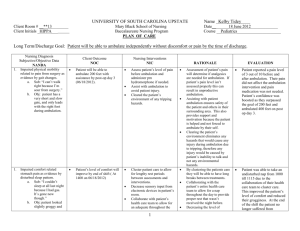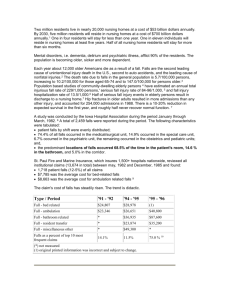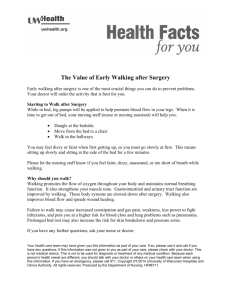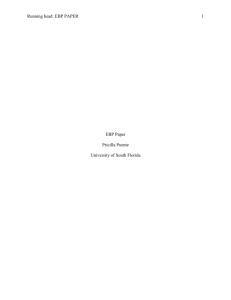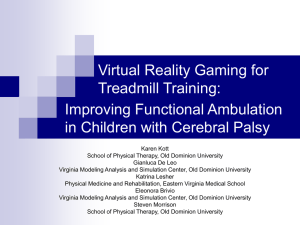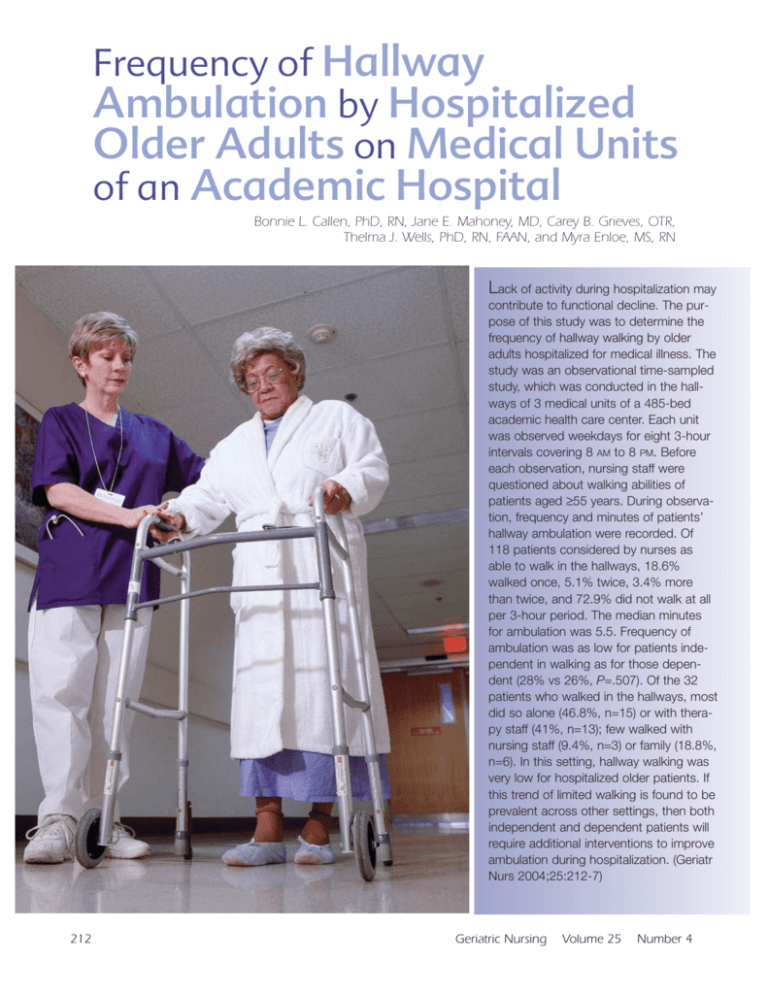
Frequency of Hallway
Ambulation by Hospitalized
Older Adults on Medical Units
of an Academic Hospital
Bonnie L. Callen, PhD, RN, Jane E. Mahoney, MD, Carey B. Grieves, OTR,
Thelma J. Wells, PhD, RN, FAAN, and Myra Enloe, MS, RN
Lack of activity during hospitalization may
contribute to functional decline. The purpose of this study was to determine the
frequency of hallway walking by older
adults hospitalized for medical illness. The
study was an observational time-sampled
study, which was conducted in the hallways of 3 medical units of a 485-bed
academic health care center. Each unit
was observed weekdays for eight 3-hour
intervals covering 8 AM to 8 PM. Before
each observation, nursing staff were
questioned about walking abilities of
patients aged ≥55 years. During observation, frequency and minutes of patients’
hallway ambulation were recorded. Of
118 patients considered by nurses as
able to walk in the hallways, 18.6%
walked once, 5.1% twice, 3.4% more
than twice, and 72.9% did not walk at all
per 3-hour period. The median minutes
for ambulation was 5.5. Frequency of
ambulation was as low for patients independent in walking as for those dependent (28% vs 26%, P=.507). Of the 32
patients who walked in the hallways, most
did so alone (46.8%, n=15) or with therapy staff (41%, n=13); few walked with
nursing staff (9.4%, n=3) or family (18.8%,
n=6). In this setting, hallway walking was
very low for hospitalized older patients. If
this trend of limited walking is found to be
prevalent across other settings, then both
independent and dependent patients will
require additional interventions to improve
ambulation during hospitalization. (Geriatr
Nurs 2004;25:212-7)
212
Geriatric Nursing
Volume 25
Number 4
L
ack of physical activity in the hospital may contribute to decline in function and loss of walking
independence in older patients. One-third of hospitalized older adults deteriorate in their ability to
perform activities of daily living,1,2 and approximately 1 in 7 becomes newly dependent on others
to walk across a small room.3,4 Decline in function
and mobility predisposes patients to multiple adverse outcomes, including falls,5,6 nursing home placement,7 and
persistent functional and walking dependence.1,3The
extent to which decline in patient mobility and function is
related to underlying illness versus lack of physical activity is not clear. Indirect evidence suggests, however, that
bed rest contributes substantially to functional decline.5,8
Although studies in humans are lacking, data from animal
models suggest that frequent ambulation may help maintain physical performance during periods of extended rest
in bed.9-11
There is little research examining the frequency of
ambulation and physical activity by hospitalized older
adults. Lazarus and colleagues, in a multisite retrospective
chart review, found that 24% of patients aged ≥65 in acute
medical-surgical units had no nursing-documented ambulation during the first 7 hospital days; only 12% of these
patients received physical therapy.12 It is possible, however, that ambulation took place but was not recorded. Thus,
an initial question is to what extent do elderly acute care
hospitalized patients ambulate?
The purposes of this observational study were 1) to
document the frequency and duration of hallway ambulation by hospitalized older adults on general medicine units
of an acute care hospital and 2) to compare the frequency
of ambulation for patients able to walk independently and
those needing human assistance to do so.
by the study investigator, for a total of 8 observation periods
per unit over a period of 5 months. Thus, each unit was
observed for 24 hours. The total observation for all 3 units
combined was 72 hours. Units were observed on a rotating
basis, and each unit was observed only once per week.
Unit Configuration
Each of the medical units is similar. Four hallways,
measuring 8 feet in width, intersect to form the shape of a
cross. Each hallway contained 4 to 10 patient rooms. The
unit desk was at one corner of the middle section.
Data Collection from Nursing
Data were collected on all patients aged ≥55 years, hospitalized on the selected units at the time of observation.
Before each observation period, information relating to
the patients’ activities in the previous 24 hours was gathered from unit nursing staff members (RNs and LPNs).
Nurses were asked the following questions:
• Is the patient able to walk in the hallway?
• If able to walk, does he or she require assistance from
a person or an assistive device?
• If unable to walk in the hallway, is the patient able to
walk in the room, or transfer but not walk?
Data Collection from Observation
After gathering information from nursing staff, the
observer sat in a corner of the middle section of the unit
where, of necessity, 1 hallway could not be viewed. By
chance, however, 1 hallway always existed where no
patient was considered able to walk in the halls. This
allowed the observer to arrange seating so that all patients
who were able to walk could be watched. Activity in
patients’ rooms was not observed.
For each patient hallway walk, the observer noted the
METHODS
time and duration, route taken, apparent purpose, and
This study was approved by the Human Subjects
presence of human assistance or assistive device. Purposes
Institutional Review Board of the
for hallway ambulation were based on
University of Wisconsin. The study
There is little research observer judgment and classified as
was conducted over 5 months in 1998
being for therapy, for a purpose other
on 3 medical units of the University of
than therapy, and for exercise. For therexamining the
Wisconsin Hospital, a 485-bed acaapy was defined as observing a patient
frequency of
walking with a nurse or off-unit health
demic health care center that provides
professional (physical therapy, exercise
both community and tertiary care. Unit
ambulation and
physiology, or respiratory care). For a
1 (27 beds) comprised patients primarpurpose other than therapy was
ily on general medical and renal serphysical activity by
defined as walking that had a definite
vices; Unit 2 (29 beds) comprised prihospitalized
goal (eg, going to the unit desk, walkmarily gastrointestinal, pulmonary, and
ing to talk with a nurse, getting on a
postintensive care patients, including
older adults.
gurney, or walking to the elevator). For
ventilator dependent patients; and Unit
exercise was defined as walking alone
3 (17 beds) comprised geriatric and
or with family with no observable goal for ambulation.
adult family practice patients.
For patients who walked off the unit, if it was obvious
The design was a time sample. For each unit, the weekto the observer that they were walking uninterrupted in a
day period 8 AM to 8 PM was divided into 4 nonoverlapping
circular route (n=4), their total time ambulating was
3-hour intervals (8-11 AM, 11 AM-2 PM, 2-5 PM, and 5-8 PM)
recorded, including time out of sight. Otherwise (n=3), the
of observation. Each 3-hour time sample was observed twice
July/August 2004
213
Table 1. Characteristics of Patients Aged ≥ 55 Years (N=235)
Able to Walk in Hallway
Total
Independent* Dependent†
(n=61)
(n=57)
P Value (n=118)
Median age in years (range)
73 (55-93)
76 (56-102)
.110 74 (55-102)
Female, n (%)
30 (49.2)
37 (64.9)
.062 67 (56.8)
5 (1-63)
.296
4 (1-63)
Length of stay (days), median (range) ‡ 4 (1-30)
Level of mobility, n (%)
Walk in room
Transfer to chair
Bedbound
Unable to Walk in Hallway
(n=117)
73 (55-90)
65 (55.6)
5 (0-62)
P Value
.898
.896
.007
26 (22.2)
53 (45.3)
38 (32.5)
*
Independent defined as able to walk in hallway without assistance from another person.
Dependent defined as needing human assistance. Classification based on nursing judgment.
‡ Refers to length of stay before observation date.
†
time walking was estimated at 10 minutes, based on an
approximate roundtrip ambulation time for the common
off-unit destinations (cafeteria, gift shop).
between groups were performed using Mann-Whitney
(for 2 groups) or Kruskal-Wallis (for >2 groups).
Categorical data were compared by Fisher exact test for 2
groups and Pearson chi-square test
Sample for Analysis
for more than 2 nonordered
The sample for analysis congroups. All data were tested for
Of the patients considered
sisted of a timed sample of
across-unit differences. Level of
able to walk in the halls, significance was set at .05, and all
patients aged ≥55 years who
were considered by nursing
tests were 2-tailed. Data were ana48.3% were considered
staff as able to walk in the
lyzed by SPSS (Statistical Package
halls, plus any patients who
for the Social Science for
dependent on another
walked even though described
Windows).13
person
to
do
so
(
44
needed
as unable to do so. Data from
For analysis of frequency of
the 24 hours of observation per
ambulation,
the number of patients
standby assistance, 12
unit periods were summed to
who were able to walk in any given
total 72 hours of observation.
3-hour period was small, and
hands-on assistance of 1
During the 72 hours of observatherefore data were combined
person, and 1 hands-on
tion, 479 patients were hospiacross all observation periods. To
talized on the 3 units; 248
calculate total on-unit patient-minassistance of 2 people).
(51.8%) were aged ≥55 years,
utes, off-unit nonwalking minutes
of whom 117 patients were considered unable to walk to
were subtracted from the 180 minutes of observation.
the hallway (38 bed bound, 53 able to transfer but not
Informed consent was not obtained because no data
ambulate, and 26 able to walk in room only). One hunwere collected for individuals and no identifying informadred sixteen patients were considered able to walk in the
tion was obtained.
halls. The nurses were unable to classify 13 patients
R E S U LT S
because of extraneous factors such as isolation to room
that precluded their ability to judge. Two patients were
Characteristics of Patients Able to Walk in the Halls
considered unable to walk to the hallway but did. These
Table 1 shows demographic characteristics of the 118
were added to the 116 for a final sample of 118 indepatients classified as able to walk in the halls or who were
pendent walkers.
observed to walk and contrasts this with the 117 patients
considered unable and who were not observed to walk. Of
Data Analysis
patients considered able to walk in the halls, 48.3%
The sample for analysis was walking done by patients.
(n=57) were considered dependent on another person to
Continuous data were evaluated for normality of distribudo so (44 needed standby assistance, 12 hands-on assistion. Data that were not normally distributed (patient age,
tance of 1 person, and 1 hands-on assistance of 2 people).
length of stay, numbers of walks, minutes of walks) were
Table 1 further compares those considered independent
summarized by medians and ranges, and comparisons
and dependent in hallway ambulation. Patients considered
214
Geriatric Nursing
Volume 25
Number 4
Table 2. Characteristics of Walking Comparing Patients Independent and Dependent in Ambulation (n=32)
Median minutes walked‡ (range)
Ambulated alone, n (%)
Ambulated with therapy staff, n (%)
Ambulated with nursing staff, n (%)
Ambulated with family, n (%)
Purpose of walk, n (%) Therapy
Other, nontherapy purpose
Exercise
Various walks/various reasons§
Assistive device use, n (%)
Independent* walkers
(n=17)
10 (1-36)
13 (76)
4 (23.5)
1 (5.9)
3 (17.6)
2 (11.8)
4 (23.5)
6 (35.3)
5 (29.4)
6 (35.3)
Dependent† walkers
(n=l5)
4 (1-25)
2 (13.3)
9 (60.0)
2 (13.3)
3 (20.0)
11 (73.3)
1 (6.7)
3 (20.0)
0 (0)
10 (66.7)
P Value
.042
<.001
.041
.452
.608
.077
* Independent defined as able to walk in hallway without assistance from another person.
† Dependent defined as needing human assistance. Classification based on nursing judgment.
‡ Total minutes walked per 3-hour period.
§ Various walks/various reasons: 3 patients walked for therapy and exercise, 2 walked for other nontherapy purpose and exercise.
independent did not differ from those considered dependent in either age or length of stay before observation.
Patients needing human assistance were significantly
more likely to use ambulation aids (P<.001), with 36.8%
(n=21) using a walker and 7.0% (n=4) using a cane. Of
those not needing human assistance, 9.8% (n=6) used a
walker, and the remainder used no device.
There were no significant differences across units in the
percentage of patients aged ≥55 years who were considered able to walk in the hallways (57% of patients aged
≥55 years on Unit 1, 44% on Unit 2, 50% on Unit 3,
P=.234). Among patients considered able to walk in the
halls, there were no significant across-unit differences in
age, gender, hospital length of stay, or frequency of need
for human assistance.
Hallway Ambulation
In the twenty-four 3-hour observation periods, there
were 55 hallway walks by 32 patients, representing 27.1%
of the sample. On average in a 3-hour period, 18.6% of
patients who were considered able to walk walked once,
5.1% twice, 3.4% 3 or more times, and 72.9% did not walk
at all. In 19,363 on-unit patient-minutes, only 318 (1.6%)
were used in hallway walking. The median time of walking in a 3-hour period by patients who walked was 5.5
minutes (range 1-36). There were no significant differences in the percentage of patients who walked by unit
(31.3%, 16.1%, and 30.8% for units 1, 2, and 3, respectively; P=.276). Figure 1 shows that there was no significant difference in frequency of ambulation comparing
those considered able to walk independently (n=67) and
dependently (n=57).
Characteristics of Patients’ Walks Comparing Walkers
from Independent and Dependent Groups
Seventeen patients from the independent group took 37
July/August 2004
walks; 15 patients from the dependent group took 18
walks. As shown in Table 2, patients who were considered
independent walked for a significantly longer amount of
time compared with those considered dependent. Only a
small percentage of patients in either group ambulated
with nursing staff, and only approximately 20% of patients
in each group ambulated with family or friends. Patients
who were considered dependent were significantly more
likely to walk for the purpose of therapy.
Time of Walking
During the daytime, the percentage of patients who
walked in each 3-hour interval remained fairly constant,
with 30%, 33%, and 30% of patients walking during the
intervals 8 to 11 AM, 11 AM to 2 PM, and 2 to 5 PM, respectively. In contrast, from 5 to 8 p.m., only 13.1% of patients
walked. These differences were not significant (P=.313).
The decrease in ambulation frequency from 5 to 8 PM was
due to a decline in both staff-assisted and staff-unassisted
(ie, patient walked alone or with family) ambulation.
Staff-assisted ambulation occurred for 12.9%, 13.9%, and
13.2% of patients during the daytime intervals of 8 to 11
AM, 11 AM to 2 PM, and 2 to 5 PM. Staff-assisted ambulation decreased to 3.3% from 5 to 8 PM. Staff-unassisted
ambulation occurred for 17.1%, 19.1%, and 16.8% of
patients during the daytime intervals, and decreased to
9.8% from 5 to 8 PM.
DISCUSSION
In this study, we observed the frequency and duration
of ambulation by patients aged ≥55 years on 3 general
medical units of an academic health care center. We found
that in any 3-hour period (between 8 AM to 8 PM), few of
the patients evaluated by nurses as able to walk, walked in
the hospital hallways. The amount of walking was low
both for patients considered able to walk independently
215
Figure 1. Frequency of hallway ambulation in a 3-hour period by
patients considered independent (n=61) and dependent (n=57) in
ambulation. P=.678 for comparison of groups; Kruskal-Wallis test.
80
70
% of Patients
60
50
Dependent
Independent
40
30
20
10
0
No
walks
1
walk
2
walks
3+
walks
Number of walks
and for those needing human assistance, with no statistically significant difference between these groups.
For patients who required assistance to walk, most
patients who walked did so with a member of hospital staff,
particularly therapy staff. Few walked with family members. This highlights the fact that for those requiring human
assistance, family aid alone is not adequate. It is startling
that so few patients walked with nursing staff. Patient
walking may not be a high priority for nursing staff in acute
care where patient problems are complex, length of stay is
short, and the pace of work fast and technically oriented.
Furthermore, nurse staffing levels may be inadequate to
provide other than technical monitoring skills in acute care.
Surprisingly, the frequency of hallway walking was
equally low for patients able to walk independently. To our
knowledge, there are no previous data quantifying ambulation by hospitalized patients who are independent in
walking and few data regarding factors that prevent walking. There may be a number of reasons that patients who
are considered able to ambulate independently do not do
so in the hospital:
• Acute medical illness may affect ambulation.
• Patients may be occupied by diagnostic evaluations
or therapies or may be too tired. Even if patients are
not occupied, they may avoid activity, fearing it may
be detrimental to their condition.
• Patients may feel a loss of mastery. In the community setting, walking behavior is positively related to
high mastery.14 Feelings of loss of mastery might be
expected to increase during hospitalization.
• Extrinsic factors such as hallway traffic, noise,
clutter in the hospital halls, the design of hospital
gowns, intravenous and other lines, and lack of
mobility aids (e.g., eyeglasses, canes, and walkers)
may serve as physical and psychological barriers to
hallway ambulation.15
216
• Patients may not ambulate because they fear falling.
Howland and colleagues found that 55% of older
adults had some degree of fear of falling, and 56%
curtailed their activities because of this.16 In the hospital, fear of falling may be more prevalent and result
in greater activity curtailment.
• An important and potentially remediable reason for
insufficient walking may be lack of emphasis on the
benefit of ambulation by physicians, administrators,
and other hospital staff. Patients may not understand
the importance of maintaining ambulation, and
physicians and other health professionals may not
discuss an appropriate level of activity with patients.
In a multisite study, there were no physician orders
for activity for 13% of patient hospital days.12 Even
when ambulation orders are present, they are often
written as “up ad lib”; it is not clear how this is interpreted. Ambulation should be clearly formulated as a
goal for acute care. Ample time should be provided
for nursing staff to ambulate patients.
• Finally, involving the patient and patient’s family in
goal setting may increase the patient’s perceived level
of control and adherence with ambulation activities.
• Our study has several limitations. First, it was constrained by observational design. This design did not
allow us to collect individual data. We were unable
to observe activity in patients’ rooms. Second, we
only observed a 3-hour block of time and do not
know how often patients ambulated throughout the
rest of the day. Third, we only observed units during
weekdays. The activity level of patients on weekends may be different. Fourth, we did not assess factors that encourage or impede self-initiated walking;
this is an important area for future study. Lastly, this
study was limited to 1 academic health care center
and may not generalize to other hospitals. It is
unknown whether smaller community hospitals, for
example, may foster an environment more conducive to ambulation. Given the current pressures to
maximize revenues and decrease hospital staffing
costs, we suspect that our findings may be similar to
those of other hospitals.
In our study, determination of the patient’s ability to
ambulate and need for assistance was based on nursing
judgment. It is not clear to what extent nursing classification was based on objective assessment of a patient’s
mobility or on subjective assumptions. Indeed, we
observed 2 patients ambulating in the hallway who had
been classified as unable to do so. Thus, nursing language,
decision making, and intervention about mobility in acute
care is an important area for further study.
I M P L I C AT I O N S F O R N U R S I N G
Despite the limitations of this study, there are clear
implications for nursing to enhance hallway ambulation in
the medical patient population. For patients hospitalized
Geriatric Nursing
Volume 25
Number 4
for medical conditions, nurses can be taking more responsibility for establishing walking routines for patients.
Activity orders, either by nurses or physicians, could be
more directive (ie, ambulate once per shift). Patient and
family education that stresses the importance of ambulation should be standard for all patients capable of walking
with or without assistance. Encouraging the use of comfortable clothing in place of the hospital gown whenever
possible is likely to encourage more independent walking.
Establishing unit routines to ensure that walking is a routine part of care (in much the same way as postoperative
ambulation is routine) would likely result in more time
spent in ambulation by both dependent and independent
walkers. Utilizing bathrooms over bedside commodes and
incorporating a hallway walk with a trip to the bathroom
provide for greater ambulation. Nursing is in a key position to ensure that physical therapy is prescribed whenever appropriate. Finally, there are likely some novel
approaches that could be taken to improve ambulation of
hospitalized medical patients, such as providing an incentive or reward for patients who meet walking goals.
We conclude that hallway ambulation by both hospitalized medical patients who walk independently and
those who walk with assistance is low. Interventions are
needed to improve ambulation in the hospital setting. For
both groups, such interventions must ultimately be tested
for their efficacy in improving patients’ balance, gait
speed, and endurance, providing greater independence in
walking and decreasing the rate of hospital and posthospital falls. Based on our current knowledge of the adverse
effects of bed rest, however, efforts to increase ambulation for hospitalized older adults should be a high priority for hospital care.
REFERENCES
1. Sager MA, Franke T, Inouye SK, et al. Functional outcomes of acute medical
illness and hospitalization in older persons. Arch Int Med 1996;156:645-52.
2. Hirsch CH, Sommers L, Olsen A, et al. The natural history of functional morbidity in hospitalized older patients. J Am Geriatr Soc 1990;38:1296-1303.
3. Mahoney JE, Sager MA, Jalaluddin M. New walking dependence associated
with hospitalization for acute medical illness: incidence and significance. J
Gerontol 1998;53A:M307-12.
July/August 2004
4. McVey LJ, Becker PM, Saltz CC, et al. Effect of a geriatric consultation team
on functional status of elderly hospitalized patients. Ann Intern Med
1989;110:79-84.
5. Mahoney JE. Immobility and falls. Clin Geriatr Med 1998;14:699-725.
6. Mahoney J, Sager M, Dunham NC, Johnson J. Risk of falls after hospital discharge. J Am Geriatr Soc 1994;42:269-74.
7. Rudberg MA, Sager MA, Zhang J. Risk factors for nursing home use after hospitalization for medical illness. J Geron A Biol Sci Med 1996;51A:M189-94.
8. Creditor MC. Hazards of hospitalization of the elderly. Ann Intern Med
1993;118:219-23.
9. Brown M, Hasser EM. Weight-bearing effects on skeletal muscle during and
after simulated bed rest. Arch Phys Med Rehabil 1995;76:541-6.
10. Periotti DJ, Roy RR, Flores V, Edgerton VR. Influence of 7 days of hindlimb
suspension and intermittent weight support on rat muscle mechanical properties. Aviat Space Environ Med 1990;61:205-10.
11. Graham SC, Roy RR, West SP, et al. Exercise effects on the size and metabolic properties of soleus fibers in hindlimb-suspended rats. Aviat Space Environ
Med 1989;60:226-34.
12. Lazarus BA, Murphy JB, Coletta EM, et al. The provision of physical activity
to hospitalized elderly patients. Arch Intern Med 1991; 151:2452-6.
13. Statistical Package for the Social Science for Windows, release 8.0.0. Chicago,
Ill. 1997.
14. Simonsick EM, Guralnik JM, Fried LP. Who walks? Factors associated with
walking behavior in disabled older women with and without self-reported walking difficulty. J Am Geriatr Soc 1999;47:672-80.
15. Palmer RM. Acute hospital care of the elderly: minimizing the risk of functional decline. Cleve Clin J Med 1995;62:117-28.
16. Howland J, Lachman ME, Peterson FW, et al. Covariates of fear of falling and
associated activity curtailment. Gerontologist 1998;38:549-55.
BONNIE L. CALLEN, PhD, RN, is an assistant professor at the School of
Nursing, University of Tennessee, Knoxville,Tennessee; JANE E. MAHONEY,
MD, is an assistant professor of Geriatrics at the Geriatric Section,
Department of Medicine, University of Wisconsin Medical School; CAREY
B. GRIEVES, OTR, is with the Shawano Medical Center, Shawano, Wisconsin;
THELMA J. WELLS, PhD, RN, FAAN, is Professor Emerita at the School of
Nursing, University of Wisconsin, Madison; and MYRA ENLOE, MS, RN, is
Patient Safety Officer at the University of Wisconsin Hospital, Madison.
Acknowledgements
The authors gratefully acknowledge Reenie Euhardy, PT, GCS,
Susan Hughes, RN, MS, and Betty Hasselkus, PhD, OTR, for
thoughtful reviews of an earlier version of this manuscript. This
research was supported by the National Institute on Aging though
a Clinical Investigator Award to Dr. Mahoney (K08AG00623)
and by the Wisconsin Women’s Health Foundation.
0197-4572/$ - see front matter
© 2004 Elsevier Inc. All rights reserved.
doi:10.1016/j.gerinurse.2004.06.016
217


